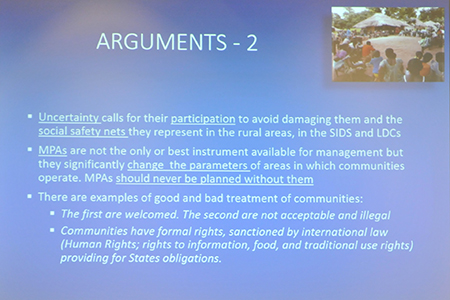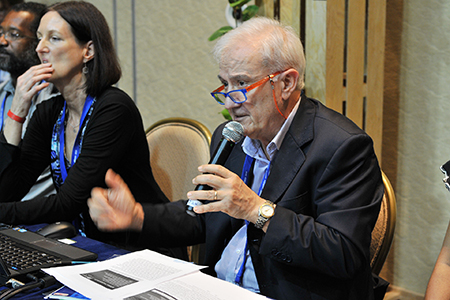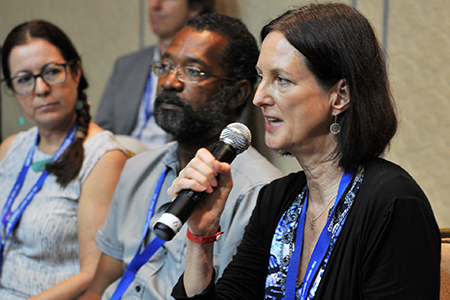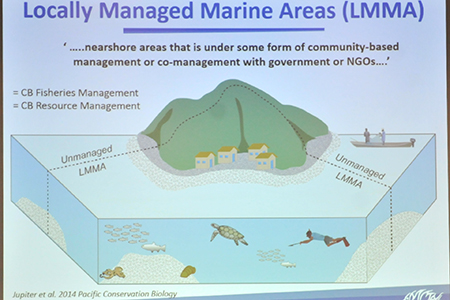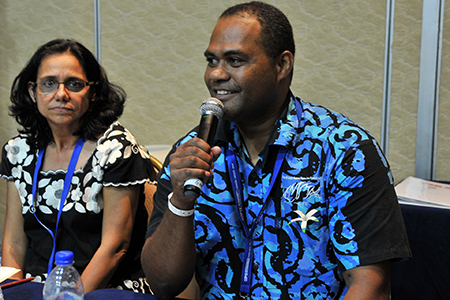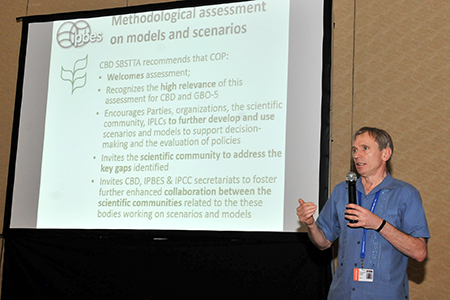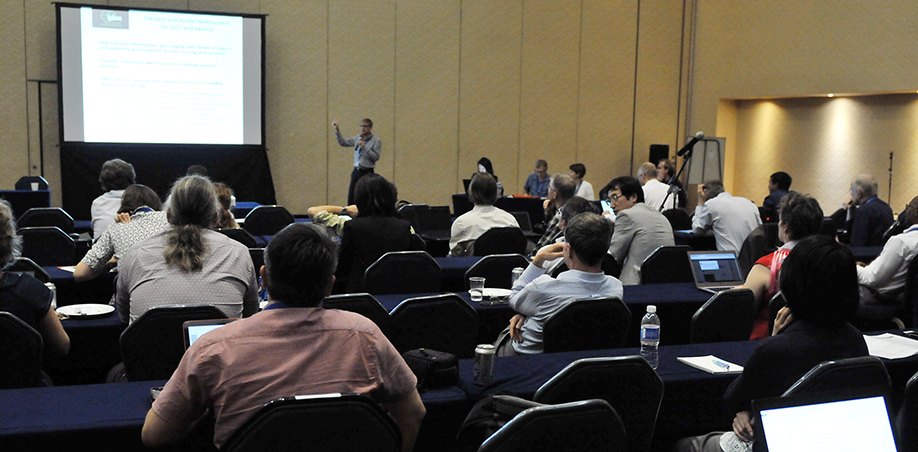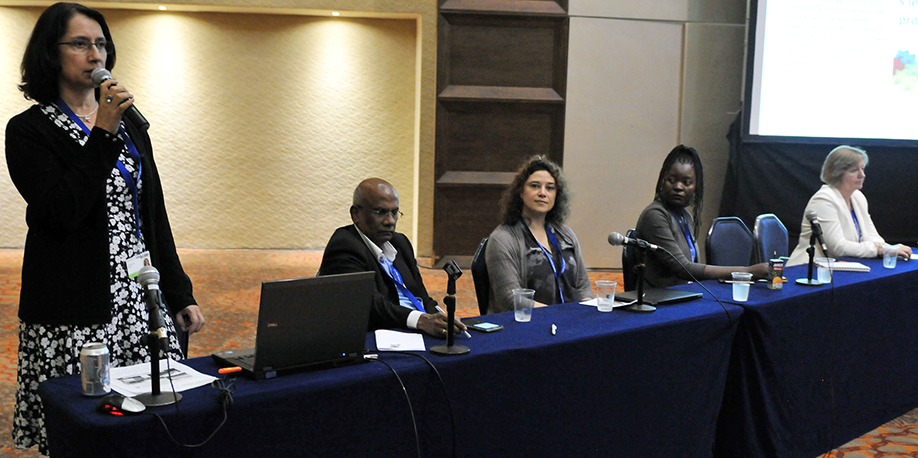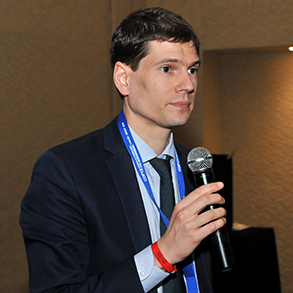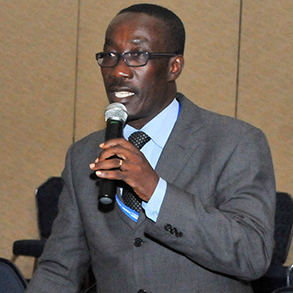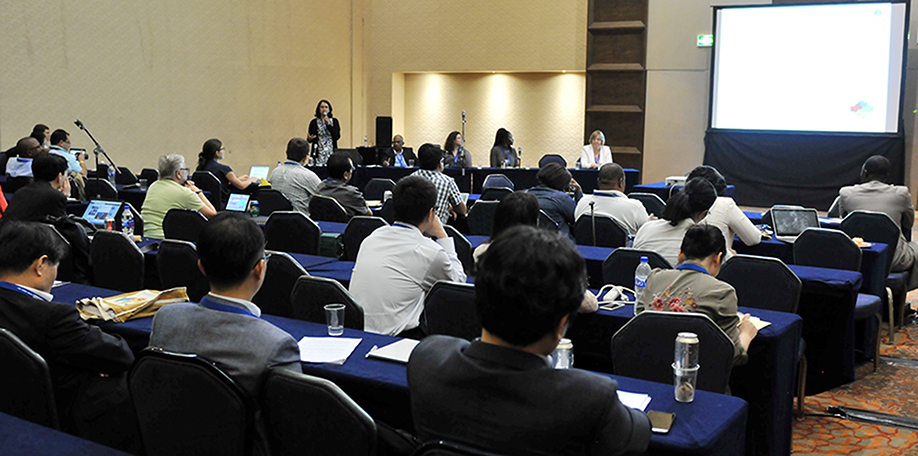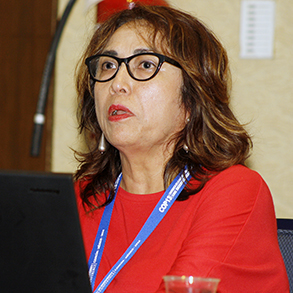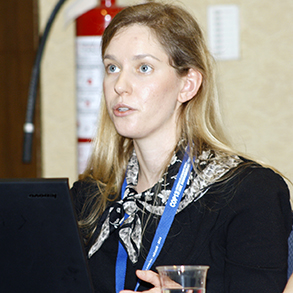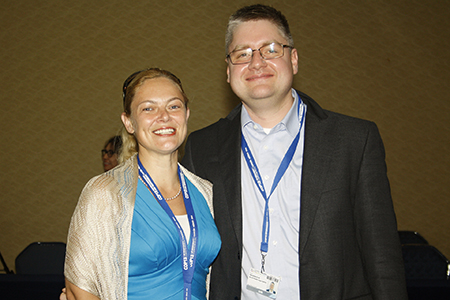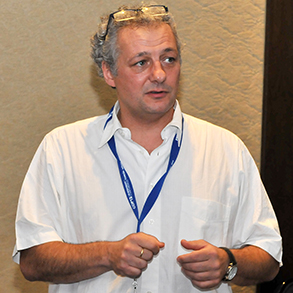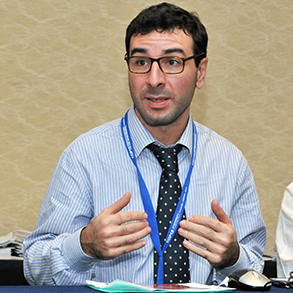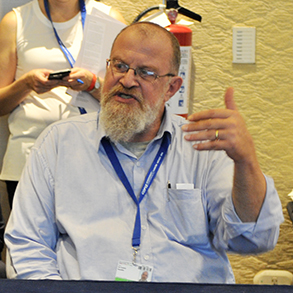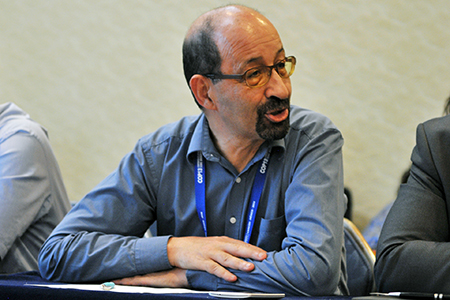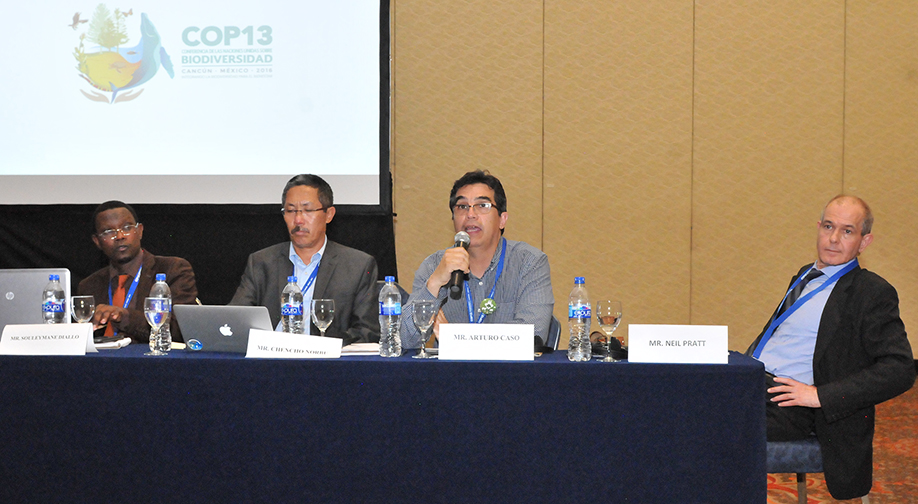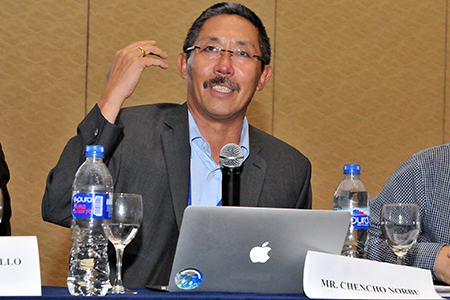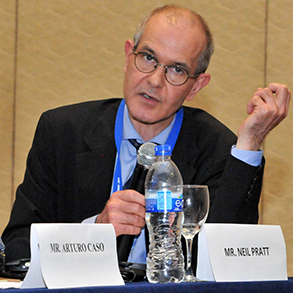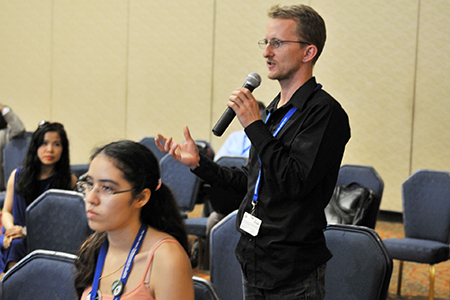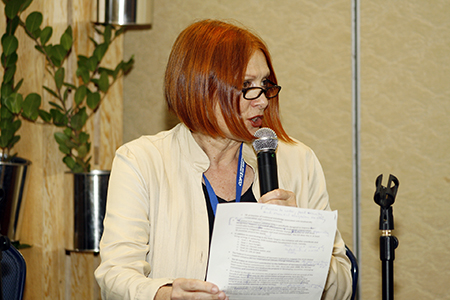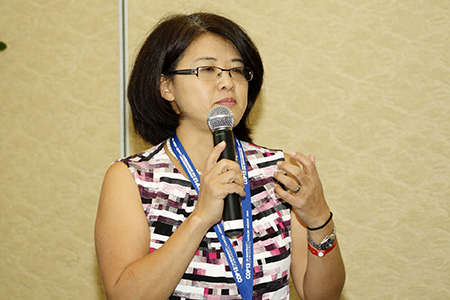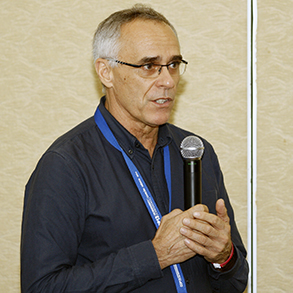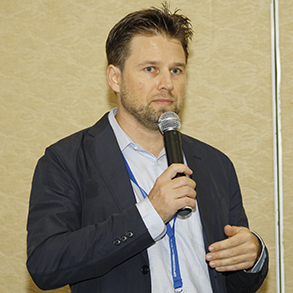Summary
The following events were covered by IISD Reporting Services On Wednesday, 7 December 2016:
- Small-scale Fisheries and Aichi Biodiversity Target 11: The Importance of Livelihoods and Food Security in Marine Protected Areas (MPAs)
- The Intergovernmental Science-Policy Platform on Biodiversity and Ecosystem Services (IPBES) Global Assessment on Biodiversity and Ecosystem Services
- Mainstreaming Biosafety Experiences from a Global Project on Integrated Implementation of the Convention on Biological Diversity (CBD) and Cartagena Protocol on Biosafety at the National Level
- Bridging the Science-Policy Gap for Biodiversity and Human Health: From Science to Practice
- Considering Intellectual Property in the Implementation of the Nagoya Protocol
- Synergies Across the Multilateral Environmental Agreements (MEAs) Towards Sustainable Development
- Strengthening Global Partnerships to Recognize the Role of Indigenous Peoples’ and Community Conserved Territories and Areas (ICCAs) in Achieving the Convention on Biological Diversity (CBD) Aichi Biodiversity Targets 11, 14, and 18
IISD Reporting Services, through its ENBOTS Meeting Coverage, is providing daily web coverage of selected side-events from the UN Biodiversity Conference.
Photos by IISD/ENB | Diego Noguera
For photo reprint permissions, please follow instructions at our Attribution Regulations for Meeting Photo Usage Page.
Small-scale Fisheries and Aichi Biodiversity Target 11: The Importance of Livelihoods and Food Security in Marine Protected Areas (MPAs)
Presented by: the Food and Agriculture Organization of the UN (FAO) Fisheries and Aquaculture Department; IUCN Commission of Ecosystem Management, Fisheries Expert Group (IUCN-CEM-FEG); the European Bureau of Conservation and Development (EBCD); and the International Collective in Support of Fishworkers (ICSF)
This event, moderated by Lena Westlund, FAO, considered the important role of small-scale fishers as part of the solution to healthy marine ecosystems, particularly in coastal areas. It also highlighted the Voluntary Guidelines for Securing Sustainable Small-scale Fisheries in the Context of Food Security and Poverty Eradication (the SSF Guidelines).
Westlund said that achieving Aichi Biodiversity Target 11 on MPAs and other effective area-based measures (OEABMs) depends on mainstreaming effective fishing community participation.
Serge García, IUCN-CEM-FEG, explained why mainstreaming community participation in MPAs and OEABMS is important, underscoring that communities have formal rights to ecosystem services, and that human rights, including the right to food, should be secured if MPAs are to become successful.
Alifereti Tawake, Pacific Locally Managed Marine Area (LMMA) Network, discussed the legal and institutional framework and processes enabling LMMAs. She said LMMAs are critical as they help reduce the tragedy of the commons by facilitating adaptive management through fisheries associations.
Minerva Arce, El Colegio de la Frontera Sur (ECOSUR), reported on the recognition of human rights and norms of indigenous peoples in the Mexican constitution. She cited the ‘Too Big To Ignore’ project, which addresses community-based and participatory approaches for sustainable small-scale fisheries.
Mitchell Lay, Caribbean Network of Fisherfolk Organization (CNFO), shared the challenges of MPAs in the Caribbean, and said they have benefited tourism more than fisheries. Citing the example of the set up and expansion of an MPA in Belize, he noted that fishers’ cooperatives were weakened as tourism blossomed, with fishers displaced from meaningful livelihoods.
Vivienne Solis, ICSF, Costa Rica, said the SSF Guidelines have been useful in creating co-management structures and cited the formation of Marine Responsible Fishing Areas spearheaded by fishermen in Costa Rica. She referred to awareness raising, training of trainers, workshops and other activities to popularize the wider use of the SSF Guidelines in Central America.
In discussions, participants noted that, inter alia: MPAs should consider equity within the fisheries supply chain, particularly in regards to middlemen; and that finding a solution to fish spoils en route to markets will also address fishing pressure.
(L-R): Vivienne Solis, ICSF; Mitchell Lay, CNFO; Lena Westlund, FAO; Serge García, IUCN-CEM-FEG; Minerva Arce, ECOSUR; and Alifereti Tawake, Pacific LMMA Network
A slide from the presentation of Serge García
Serge García, IUCN-CEM-FEG, said MPAs are one of many mechanisms available to manage fisheries and urged for integration and mainstreaming of OEABMs.
Minerva Arce, ECOSUR, discussed good practices for ensuring community participation in aquatic conservation, MPAs and OAEBMS.
Lena Westlund, FAO, said the FAO Committee on Fisheries endorsed the SSF Guidelines in 2014.
A slide from the presentation of Alifereti Tawake
Alifereti Tawake, Pacific LMMA Network, said Fiji is committed to achieving 100% inshore management covering over 35,000 km2 by 2020.
Participants during the event
Contact:
- Lena Westlund (Coordinator)
| lena.westlund@fao.org - Despina Symons-Pirovolidou (Coordinator)
| despina.symons@ebcd.org
More Information:
The Intergovernmental Science-Policy Platform on Biodiversity and Ecosystem Services (IPBES) Global Assessment on Biodiversity and Ecosystem Services
Presented by IPBES and the Convention on Biological Diversity (CBD)
This side event, moderated by Anne Larigauderie, Executive Secretary, IPBES, discussed the relevance of the IPBES work programme 2014-2018 in informing progress towards the fifth Global Biodiversity Outlook (GBO-5), the Aichi Biodiversity Targets and the review of implementation of the Strategic Plan for Biodiversity 2011-2020, through thematic, regional and global assessments and scenario analysis and modeling.
Hien Ngo, IPBES Secretariat, stated that the Assessment will critically assess the state of knowledge on past, present and future biodiversity and ecosystem services trends across diverse worldviews and knowledge systems of humans and nature.
Mark Rounsevell, The University of Edinburgh, discussed the implications of four regional assessments, which will feed into the Global Assessment to examine the drivers of change, potential impacts of policy and knowledge gaps that need to be addressed. He emphasized that regional assessments will respond directly to requests from governments and will be “broader and more inclusive” than previous assessments by taking into account conceptualizations of values and worldviews to understand nature’s benefits.
Paul Leadley, University of Paris-Sud, presented on the role of scenarios and models in the IPBES Global Assessment in stimulating research by: identifying knowledge gaps; supporting the networking of scientists, policymakers and practitioners; developing strategies for mobilizing stakeholders through multi-scale participatory scenarios; and facilitating the inclusion of indigenous and local knowledge.
David Cooper, Deputy Executive Secretary, CBD, stated that the Subsidiary Body on Scientific, Technical and Technological Advice (SBSTTA) welcomed the IPBES work programme to support the work of the Convention and for developing recommendations for consideration by the Conference of the Parties (COP).
In the ensuing discussion, participants considered, inter alia: the effectiveness of model-based assessments for assessing future trends in biodiversity and ecosystem services; how biophysical data on biodiversity can be integrated with direct and indirect socio-economic drivers of change; and the extent of capacity building available to support the use of scenarios and modeling for biodiversity and ecosystem services.
(L-R): David Cooper, Deputy Executive Secretary, CBD; Hien Ngo, IPBES Secretariat; Anne Larigauderie, Executive Secretary, IPBES; Paul Leadley, University of Paris-Sud; and Mark Rounsevell, The University of Edinburgh
Paul Leadley, University of Paris-Sud, stressed that the development of new scenarios and models for biodiversity and ecosystem services is a long-term process.
David Cooper, Executive Secretary, CBD, noted that the IPBES Global Assessment will be the primary scientific basis underpinning the GBO-5.
Anne Larigauderie, Executive Secretary, IPBES, moderated the event.
Mark Rounsevell, The University of Edinburgh, discussed the challenges of harmonizing regional and global assessments for biodiversity and ecosystem services in terms of direct and indirect drivers of change and options for governance, among others.
A participant asks a question to the panel.
Participants during the event
Contact:
- Anne Larigauderie (Coordinator and Moderator)
| anne.larigauderie@ipbes.net
More Information:
Mainstreaming Biosafety Experiences from a Global Project on Integrated Implementation of the Convention on Biological Diversity (CBD) and the Cartagena Protocol on Biosafety at the National Level
Presented by the CBD
This session heard presentations on lessons learned from parties participating in the project, ‘Capacity building to promote integrated implementation of the Cartagena Protocol on Biosafety and the CBD at the national level,’ and on ongoing activities to develop capacity-building material for enhancing mainstreaming of biosafety.
Presenting on the capacity-building project, Peter Deupmann, CBD Secretariat, noted it aims to have pilot countries document experiences on practical actions to promote integrated implementation of the CBD and the Cartagena Protocol on Biosafety, and to ensure training of CBD and Cartagena Protocol national focal points on integrated implementation.
Martha Mphatso Kalemba, Malawi, identified lessons learned through implementation of the project in her country. On the way forward, she noted the need to: continue creating enabling environments and initiatives for biosafety mainstreaming; develop and implement a mainstreaming strategy; and identify additional funding opportunities to build on current momentum.
Letchumanan Ramatha, Malaysia, highlighted his country’s 2007 Biosafety Act, noting the benefits of having one law in this area that includes centralization of risk assessments, decision making and capacity-building efforts.
Sol Ortíz García, Mexico, highlighted the value of the project in: promoting an active discussion on biosafety with different stakeholders; improving collaboration between national focal points; promoting the use of a “common language” among participants; and identifying common challenges and opportunities for future policy planning and design.
Angela Lozan, Moldova, noted her country’s main findings on strengthening mainstreaming, including on: the importance of improving cross-sectorial cooperation and synchronization of activities of ministries; the need to garner political support; the need for toolkits, roadmaps and training material; and the value of regional and sub-regional cooperation to exchange best practices and lessons learned on successful mainstreaming.
Elisa Morgera, Strathclyde Centre for Environmental Law and Governance, highlighted her institute’s contribution to three outputs to promote capacity building in this area: a synthesis report of national desk studies by the project’s nine participating pilot countries; an e-learning module to enhance understanding of biosafety mainstreaming and its importance; and a more practice-focused toolkit on how biosafety mainstreaming can be achieved.
In the discussion, some participants stressed, inter alia: the need to capture biosafety in National Biodiversity Strategies and Action Plans (NBSAPs) and to ensure, in turn, that NBSAPs are integrated into national development plans; that governments should be encouraged to have one common body to manage the Convention and the Protocol; and the need to consider a variety of approaches so if a model is not feasible or appropriate in a national context, another approach can be implemented.
(L-R): Sol Ortíz García, Mexico; Letchumanan Ramatha, Malaysia; Elisa Morgera, Strathclyde Centre for Environmental Law and Governance; Martha Mphatso Kalemba, Malawi; and Angela Lozan, Moldova
On the benefits of coordinating action among different stakeholders, Sol Ortíz García, Mexico, observed that “having six different perspectives on the table takes longer, but is worth it.”
Angela Lozan, Moldova, highlighted her country’s 2015-2020 NBSAP and draft law on genetically modified organisms as examples of biosafety mainstreaming.
Among the findings of the synthesis report, Elisa Morgera, Strathclyde Centre for Environmental Law and Governance, noted that addressing information exchange; political will and the mandates of key actors and institutions may lead to enhanced access to funding for biosafety mainstreaming.
Peter Deupmann, CBD Secretariat
A participant during the discussion
Participants listening to panelists
Contact:
- Peter Deupmann (Coordinator)
| peter.deupmann@cbd.int
More Information:
- https://www.cbd.int/doc/?meeting=BSMBWS-2016-02
- http://www.strath.ac.uk/research/strathclydecentreenvironmentallawgovernance/
Bridging the Science-Policy Gap for Biodiversity and Human Health: From Science to Practice
Presented by the Convention on Biological Diversity (CBD), International Union for Conservation of Nature (IUCN), the UN University - International Institute for Global Health (UNU-IIGH), the UNU Institute for the Advanced Study of Sustainability (UNU-IAS), European Hematology Association (EHA), UN Environment, Bioversity International and TRAFFIC
Moderator Cristina Romanelli, CBD Secretariat, drew attention to the joint CBD-World Health Organization (WHO) report ‘Connecting Global Priorities: Biodiversity and Human Health, a State of Knowledge Review,’ and underscored the linkages between environment and health and achieving the Aichi Biodiversity Targets and the Sustainable Development Goals (SDGs).
Calling for closer collaboration between the WHO and CBD, Anne-Hélène Prieur-Richard, Future Earth, highlighted that the synergies now being discussed at the policy level have been discussed by scientists for years, underscoring the importance of the State of Knowledge Review in linking biodiversity to health.
Marleni Ramírez, Bioversity International, shared the organization’s work on agro-biodiversity, and noting that agro-biodiversity is shrinking, pointed to the fact that the world does not grow enough vegetables, fruits, nuts and seeds. She shared Brazil’s experience in promoting agricultural biodiversity, through widening the knowledge base on the nutritional content of 73 fruit tree species, noting that these findings are being shared through an educational programme and used in awareness-raising campaigns.
Catherine Machalaba, EcoHealth Alliance, spoke on the State of Knowledge Review’s chapter on infectious diseases, underscored the need to study hosts and pathogens together, and underlined that land-use changes for agriculture are expected to create new interactions, which could facilitate pathogen spillover. Drawing attention to a One Health approach, she highlighted the need for an ecosystems approach to health and biodiversity, and pointed to the gap of information on marine infectious diseases.
Daniel Buss, WHO, noted that the Review’s chapter on water highlights the drivers of ill health and biodiversity, including mercury contamination and endocrine disruptors. He stressed that to move to an even more integrated approach to addressing health and environment, we should redefine health to being more than just disease control, but rather as a more cross-cutting theme across the SDGs and the Aichi Biodiversity Targets.
Cristina Tirado, University of California at Los Angeles (UCLA): pointed to climate change impacts on microbial biodiversity, noting increasing resistance to antibiotics; and lamented the silos between the health, climate change, and biodiversity communities. He described the need for interdisciplinary work on biodiversity, health and nutrition within the climate change agenda.
Suneetha Mazhenchery Subramanian, International Partnership for the Satoyama Initiative, spoke on a community learning exchange between India and Africa, stressing that traditional healers are usually the first point of contact for communities regarding health and wellbeing. She also pointed to the importance of these healers for migrants and refugees. Calling for more integrated assessments that include health, wellbeing and the state of biodiversity, she stressed the need to translate the Aichi Biodiversity Targets and the SDGs for communities on the ground.
Anne-Hélène Prieur-Richard, Future Earth, stressed the need to leverage the health and biodiversity work on the ground in order to promote national, regional and global collaborations.
Marleni Ramírez, Bioversity International, said that the Rio Olympics provided a forum for athletes to speak about healthy, sustainable foods.
Catherine Machalaba, EcoHealth Alliance, cited examples of diseases from animals, plants and vectors, noting that certain communities are more affected due to poverty and nutritional deficiencies.
Cristina Romanelli, CBD Secretariat, and Daniel Hougendobler, WHO
Panel speaker photo at the end of the event.
Contact:
- Cristina Romanelli (Coordinator)
| Cristina.Romanelli@cbd.int
More Information:
Considering Intellectual Property in the Implementation of the Nagoya Protocol
Presented by the World Intellectual Property Organization (WIPO) and the Access and Benefit-Sharing (ABS) Capacity Development Initiative
This event, moderated by Claudio Chiarolla, WIPO, and Suhel al-Janabi, ABS Initiative, presented key lessons learned from multi-stakeholder practical workshops on the interface between intellectual property (IP) and ABS, and introduced new tools and resources on IP and ABS.
Al-Janabi introduced two practical multi-stakeholder workshops on IP, genetic resources, traditional knowledge and traditional cultural expressions held in Namibia and Morocco aimed at building capacity and raising awareness amongst representatives of Indigenous Peoples and Local Communities (IPLCs) and key government agencies from those countries.
Pierre du Pleissis, Advisor, African Union Commission (AUC), said there is a disconnect between the technical experts attending negotiations on the Nagoya Protocol and policymakers responsible for ABS laws.
Kauna Betty Schröder, Ministry of Environment and Tourism, Namibia, said that in order to successfully bring together IPLCs and government agencies to discuss IP and ABS, her ministry organized an initial meeting to introduce essential concepts and terminologies. She said the emphasis on practices, systems and tools enabled an understanding of the issues at stake.
Khalid Lalami, Ministry of Environment, Morocco, said the second workshop on IP and ABS allowed IPLCs and government officials to understand the importance of cooperating in the valorization of traditional knowledge and the protection of knowledge holders. He urged for more emphasis on integrating certificates of origin in patenting processes.
Chiarolla introduced upcoming capacity-building tools and resources on IP and ABS. He said resources on new patent disclosure requirements (PDRs) would be released to enable parties to, among other things, understand these new PDRs, types of remedies and sanctions for non-compliance, and their relationship with other treaties. He also reported that a guide on IP issues in ABS is in the pipeline.
In discussions, participants, inter alia: called for elaboration on issues regarding patents for gene sequences; and noted reduced research and development on traditional knowledge resources.
Suhel al-Janabi, ABS Initiative, said that argan oil is a good case study for ABS, with numerous patents but no ABS clarity.
Claudio Chiarolla, WIPO, said a study on key questions to address when developing patent disclosure requirements relating to genetic resources and traditional knowledge will be released in 2017.
Pierre du Pleissis, Advisor, AUC, said the Aichi Biodiversity Targets focus more on conservation and sustainable use and not enough on ABS.
Kauna Betty Schröder, Ministry of Environment and Tourism, Namibia, reported on the first Practical Workshop on IP and Genetic Resources, Traditional Knowledge and Traditional Cultural Expressions held in August 2016 in Windhoek, Namibia.
Khalid Lalami, Ministry of Environment, Morocco, reported on outcomes of the second Practical Workshop on IP and Genetic Resources, Traditional Knowledge and Traditional Cultural Expressions held in Marrakech, Morocco in September 2016.
Participants listening to panelists
Contact:
- Claudio Chiarolla (Coordinator)
| claudio.chiarolla@wipo.int - Suhel al-Janabi (Coordinator)
| s.aljanabi@geo-media.de
More Information:
Synergies Across the Multilateral Environmental Agreements (MEAs) Towards Sustainable Development
Presented by the Global Environment Facility (GEF)
This session, moderated by Chizuru Aoki, GEF, featured GEF efforts and country experiences in promoting synergies between the different MEAs.
Braulio Ferreira de Souza Dias, Executive Secretary, CBD, highlighted a key opportunity for countries to implement National Biodiversity Strategies and Action Plans (NBSAPs) together with Nationally Determined Contributions (NDCs) and national adaptation plans (NAPs) under the UN Framework Convention on Climate Change (UNFCCC). He also noted the thirteenth session of the Conference of the Parties to the CBD (CBD COP 13) draft decision on bringing together various national reports as “a real opportunity” to create convergence between the biodiversity-related MEAs.
Noting the GEF’s unique mandate across all global environmental concerns, Gustavo Fonseca, GEF, said that countries are signaling integration across sectors as a priority, and highlighted that 55% of the GEF’s sixth replenishment (GEF-6) financing went towards multi-focal area projects or integrated approaches.
Neil Pratt, CBD Secretariat, noted that integration of MEAs “has been under discussion for at least the last 20 years,” and highlighted renewed attention to synergies as a result of the 2030 Agenda for Sustainable Development process as an important opportunity for progress.
Chencho Norbu, National Environment Commission, Bhutan, highlighted the value of: good baseline data; top-down approaches in certain contexts; and participatory approaches and tools for informed decision making.
Arturo Caso, Ministry of Environment and Natural Resources, Mexico, highlighted two examples of GEF-supported, integrated projects in Mexico on: conservation of coastal watersheds, and creating natural protected areas through a “vegetation corridor.”
Souleymane Diallo, Ministry of Environment and Sustainable Development, Senegal, highlighted GEF-funded projects on piloting integrated and sustainable management of cities, and on food security as contributing to implementing MEAs on climate change, desertification, biodiversity and chemicals.
In the ensuing discussion, panelists discussed three guiding questions. On opportunities and barriers to promoting synergies and integrated agendas among the different MEAs, panelists noted, inter alia: geographical constraints related to where secretariats are housed; not all countries being party to each convention; the need for enhanced dialogue at the national level; the potential for common planning frameworks and monitoring progress towards the SDGs; and the potential and limitations of integrated information management.
On what countries need to foster successful, coordinated planning and implementation of MEAs and the SDGs at the national level, panelists highlighted, inter alia: sharing of information between federal and local governments; organization by the GEF focal agencies of national workshops with attendance of all Rio Convention focal points, SDG coordinators and relevant parliamentary committees; and good data systems and national-level support to track NAPs, NDCs and NBSAPs.
On suggestions to the GEF to further facilitate synergies and coordinated implementation of MEAs and the SDGs, panelists underscored, inter alia: support for capacity building; room to “rotate Conventions,” whereby a different MEA is prioritized in each GEF cycle; the need for more funding; and the need to consider how to measure project success.
During the Q&A session, participants discussed, inter alia: experiences with the national portfolio formulation exercise in supporting synergies across MEAs; how the GEF could “do the unfinished homework of the UNFCCC” by ensuring oil, coal and gas reserves are kept in the ground in biodiverse areas; opportunities for extended constituency workshops to tap into synergies; how the GEF’s approach differs when an integrated, versus a specific approach is taken to projects; concerns about whether biodiversity allocations are really covering biodiversity; and how the GEF is addressing synergies within the biodiversity-related conventions.
Participants during the event
Chencho Norbu, National Environment Commission, Bhutan, stressed “the meeting point of the environmental conventions is at the household and community level.”
Arturo Caso, Ministry of Environment and Natural Resources, Mexico, underscored that “the key is to work together, because any strategy that addresses climate change will also help biodiversity.”
Souleymane Diallo, Ministry of Environment and Sustainable Development, Senegal, noted that coordination among partners remains a key challenge in enhancing the effectiveness of integrated projects.
Chizuru Aoki, GEF
Neil Pratt, CBD Secretariat, indicated that there are also many opportunities to strengthen synergies between the MEAs in terms of communication and awareness raising, resource mobilization, and the science-policy interface.
Gustavo Fonseca, GEF, said the Facility’s mandate creates “a very complicated but very exciting” landscape for environmental financing at the global scale.
Jozef Buys, Belgium
Participants during the discussion
Participants during the event
Contact:
- Chizuru Aoki (Coordinator)
| caoki@thegef.org
More Information:
Strengthening Global Partnerships to Recognize the Role of Indigenous Peoples’ and Community Conserved Territories and Areas (ICCAs) in Achieving the Convention on Biological Diversity (CBD) Aichi Biodiversity Targets 11, 14, and 18
Presented by: the Global Environmental Facility (GEF); the GEF Small Grants Programme (GEF-SGP); the ICCA Consortium; UN Environment Programme-World Conservation Monitoring Centre (UNEP-WCMC); the German Ministries for the Environment and for Economic Cooperation and Development of the German Federal Government; and the International Union for Conservation of Nature (IUCN)
This side event, moderated by Terence Hay-Edie, GEF-SGP, began with a short video describing the Global ICCA Support Initiative (GSI). The event discussed the central role of ICCAs in achieving several Aichi Biodiversity Targets and the Sustainable Development Goals (SDGs), and in enhancing protected area governance around the world.
Elsa Nickel, Director General, Federal Ministry for the Environment, Germany, reiterated Germany’s commitment to supporting ICCAs for the achievement of the Aichi Biodiversity Targets, and underlined the role of the GSI in promoting ICCA conservation in at least 26 countries.
Yoko Watanabe, GEF, described the extent of GEF projects and portfolios, which support indigenous peoples, noting 220 full and medium-sized projects representing approximately 15% of GEF-SGP projects.
Hay-Edie, GEF-SGP, described ICCAs as either: “defined” and requiring greater recognition; “disrupted” and requiring support for the revival of traditional knowledge; or “desired” and requiring further support over time.
Trevor Sandwith, IUCN, stressed that the governance of protected areas and ICCAs should be seen in the broader context of “what’s going on in the country, jurisdiction and territory.” He noted the need to “go back to the basics” in engaging with communities to identify and understand the diverse legal regimes for protected areas that exist in the field.
Naomi Kingston, UNEP-WCMC, described a project to enhance the interoperability of global protected areas databases to enhance recognition of territories conserved by ICCAs. She noted the aim of the project is to develop a more comprehensive picture of conservation areas and to encourage ICCAs to register their territories.
Grazia Borrini-Feyerabend, ICCA Consortium, emphasized that ICCAs: refer to a “profound bond” between a human community and a natural area or territory; consist of a relationship that is “umbilical in nature”; and results in nature conservation in both visible and invisible ways that are inextricably linked to culture and livelihoods. She praised local, national and global efforts to support ICCAs, but underscored that misrecognizing ICCAs can destroy rather than help them.
In the discussion, an indigenous participant from Guatemala praised efforts in building links between indigenous peoples’ and global institutions, but cautioned against the “imposition of the ICCA concept” from global actors.
Elsa Nickel, Director General, Federal Ministry for the Environment, Germany, underscored the crucial role ICCAs play in achieving the Aichi Biodiversity Targets and the SDGs.
Yoko Watanabe, GEF Secretariat, described how the GEF is supporting the participation and capacity building of indigenous peoples and local communities in the design, implementation and management of protected areas.
Trevor Sandwith, IUCN, underscored the role of collaboration to amplify the integration, vitality and quality of governance across protected and conserved areas.
Terence Hay-Edie, GEF-SGP, stated that by the end of 2019, at least 200 ICCA projects in 20 countries will be supported.
Naomi Kingston, UNEP-WCMC, noted that ICCAs account for less than 5% of entries in the World Database on Protected Areas, yet may represent the majority of conservation governance.
Grazia Borrini-Feyerabend, ICCA Consortium, said ICCAs are the oldest successful examples of what can be considered “conservation” and closely relate culture and livelihoods with land.
A slide from Grazia Borrini-Feyerabend’s presentation.
Contact:
- Terence Hay-Edie (Coordinator)
| terence.hay-edie@undp.org


